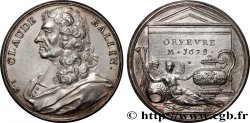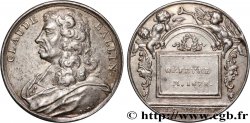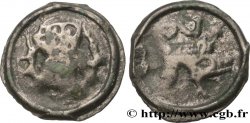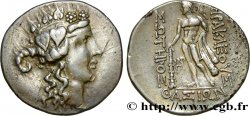fjt_251081 - DASSIER - LES HOMMES ILLUSTRES CHARLES LE BRUN 1690
240.00 €
Menge
In den Warenkorb

Type : CHARLES LE BRUN
Datum: 1690
Metall : Kupfer
Durchmesser : 28 mm
Stempelstellung : 12 h.
Rand lisse
Seltenheitsgrad : R1
Vorderseite
Titulatur der Vorderseite CHARLES LE BRUN.
Beschreibung Vorderseite Buste drapé de Charles Le Brun à droite, signé I. D. F..
Rückseite
Titulatur der Rückseite PREMIER PEINTRE DU ROY M. 1690.
Beschreibung Rückseite Son tombeau, deux anges l’encadrant et tenant une trompette, l’un y soufflant et présentant une couronne au dessus, signé I. DASSIER. F..
Kommentare
Charles Le Brun, baptisé le 24 février 1619 à Paris où il est mort le 12 février 1690, est un artiste-peintre et décorateur français, premier peintre du roi, directeur de l'Académie royale de Peinture et de Sculpture, et de la Manufacture royale des Gobelins. Il s'est surtout illustré dans la décoration du château de Versailles et de la galerie des Glaces.
Né d'un père sculpteur, Nicolas Lebrun et Charles Le Brun entre vers 1632 dans l'atelier de François Perrier. Deux ans plus tard, il est remarqué par le chancelier Pierre Séguier, qui le recommande à Simon Vouet. Il apprend son métier dans l'atelier de ce grand maître. En 1642, grâce à l’aide financière du chancelier, Le Brun part pour l'Italie, faisant le voyage de Lyon à Rome en compagnie de Nicolas Poussin. Durant son séjour italien, Le Brun copie les antiques de Rome pour le chancelier Séguier, des tableaux du Guide, de Raphaël et la galerie Farnèse des Carrache. Il peint également plusieurs tableaux dont Mucius Scaevola devant Porsenna, Horatius Coclès au pont Sublicius et une Allégorie du Tibre. Après quatre années passées en Italie, le peintre quitte Rome à la fin de l'année 1645 et rejoint Paris en mars 1646 après un court séjour à Lyon. De retour à Paris, Le Brun obtient plusieurs commandes importantes grâce à l'appui de Séguier. Dès l'année suivante, il est nommé : "Peintre et grateur de cue du roi". Il est également choisi par la corporation des Orfèvres de Paris afin de peindre le May offert à leur cathédrale. Le Brun représente alors : Le martyre de Saint André (toujours conservé à Notre-Dame de Paris). Cette même année Le Brun épouse Suzanne Butay.
Le surintendant des finances du roi, Nicolas Fouquet, lui demande de travailler à la décoration de son château de Vaux-le-Vicomte (1656-1661). Avec Philippe de Champaigne, il obtient du roi la fondation de l’Académie royale de peinture et de sculpture en 1648.
La suite de sa biographie à http://fr.wikipedia.org/wiki/Charles_Le_Brun.
Charles Le Brun, baptized on February 24, 1619 in Paris where he died on February 12, 1690, was a French painter and decorator, first painter to the king, director of the Royal Academy of Painting and Sculpture, and of the Royal Gobelins Manufactory.. He was particularly known for his decoration of the Palace of Versailles and the Hall of Mirrors..
Born to a sculptor father, Nicolas Lebrun and Charles Le Brun entered the workshop of François Perrier around 1632.. Two years later, he was noticed by Chancellor Pierre Séguier, who recommended him to Simon Vouet. He learned his trade in the workshop of this great master. In 1642, thanks to the financial assistance of the Chancellor, Le Brun left for Italy, making the journey from Lyon to Rome in the company of Nicolas Poussin. During his stay in Italy, Le Brun copied Roman antiques for Chancellor Séguier, paintings from the Guide, by Raphael and the Farnese Gallery of the Carracci. He also painted several paintings including Mucius Scaevola before Porsenna, Horatius Cocles at the Sublicius Bridge and an Allegory of the Tiber. After four years spent in Italy, the painter left Rome at the end of 1645 and returned to Paris in March 1646 after a short stay in Lyon.. Back in Paris, Le Brun obtained several important commissions thanks to the support of Séguier.. The following year, he was appointed: \\\"Painter and scraper of cue to the king\\\". He was also chosen by the corporation of Goldsmiths of Paris to paint the May offered to their cathedral. Le Brun then represents: The martyrdom of Saint Andrew (still preserved at Notre-Dame de Paris). That same year Le Brun married Suzanne Butay.
The king's superintendent of finances, Nicolas Fouquet, asked him to work on the decoration of his château of Vaux-le-Vicomte (1656-1661). With Philippe de Champaigne, he obtained from the king the foundation of the Royal Academy of Painting and Sculpture in 1648.
The rest of his biography at http://fr. Wikipedia. org/wiki/Charles_Le_Brun
Né d'un père sculpteur, Nicolas Lebrun et Charles Le Brun entre vers 1632 dans l'atelier de François Perrier. Deux ans plus tard, il est remarqué par le chancelier Pierre Séguier, qui le recommande à Simon Vouet. Il apprend son métier dans l'atelier de ce grand maître. En 1642, grâce à l’aide financière du chancelier, Le Brun part pour l'Italie, faisant le voyage de Lyon à Rome en compagnie de Nicolas Poussin. Durant son séjour italien, Le Brun copie les antiques de Rome pour le chancelier Séguier, des tableaux du Guide, de Raphaël et la galerie Farnèse des Carrache. Il peint également plusieurs tableaux dont Mucius Scaevola devant Porsenna, Horatius Coclès au pont Sublicius et une Allégorie du Tibre. Après quatre années passées en Italie, le peintre quitte Rome à la fin de l'année 1645 et rejoint Paris en mars 1646 après un court séjour à Lyon. De retour à Paris, Le Brun obtient plusieurs commandes importantes grâce à l'appui de Séguier. Dès l'année suivante, il est nommé : "Peintre et grateur de cue du roi". Il est également choisi par la corporation des Orfèvres de Paris afin de peindre le May offert à leur cathédrale. Le Brun représente alors : Le martyre de Saint André (toujours conservé à Notre-Dame de Paris). Cette même année Le Brun épouse Suzanne Butay.
Le surintendant des finances du roi, Nicolas Fouquet, lui demande de travailler à la décoration de son château de Vaux-le-Vicomte (1656-1661). Avec Philippe de Champaigne, il obtient du roi la fondation de l’Académie royale de peinture et de sculpture en 1648.
La suite de sa biographie à http://fr.wikipedia.org/wiki/Charles_Le_Brun.
Charles Le Brun, baptized on February 24, 1619 in Paris where he died on February 12, 1690, was a French painter and decorator, first painter to the king, director of the Royal Academy of Painting and Sculpture, and of the Royal Gobelins Manufactory.. He was particularly known for his decoration of the Palace of Versailles and the Hall of Mirrors..
Born to a sculptor father, Nicolas Lebrun and Charles Le Brun entered the workshop of François Perrier around 1632.. Two years later, he was noticed by Chancellor Pierre Séguier, who recommended him to Simon Vouet. He learned his trade in the workshop of this great master. In 1642, thanks to the financial assistance of the Chancellor, Le Brun left for Italy, making the journey from Lyon to Rome in the company of Nicolas Poussin. During his stay in Italy, Le Brun copied Roman antiques for Chancellor Séguier, paintings from the Guide, by Raphael and the Farnese Gallery of the Carracci. He also painted several paintings including Mucius Scaevola before Porsenna, Horatius Cocles at the Sublicius Bridge and an Allegory of the Tiber. After four years spent in Italy, the painter left Rome at the end of 1645 and returned to Paris in March 1646 after a short stay in Lyon.. Back in Paris, Le Brun obtained several important commissions thanks to the support of Séguier.. The following year, he was appointed: \\\"Painter and scraper of cue to the king\\\". He was also chosen by the corporation of Goldsmiths of Paris to paint the May offered to their cathedral. Le Brun then represents: The martyrdom of Saint Andrew (still preserved at Notre-Dame de Paris). That same year Le Brun married Suzanne Butay.
The king's superintendent of finances, Nicolas Fouquet, asked him to work on the decoration of his château of Vaux-le-Vicomte (1656-1661). With Philippe de Champaigne, he obtained from the king the foundation of the Royal Academy of Painting and Sculpture in 1648.
The rest of his biography at http://fr. Wikipedia. org/wiki/Charles_Le_Brun







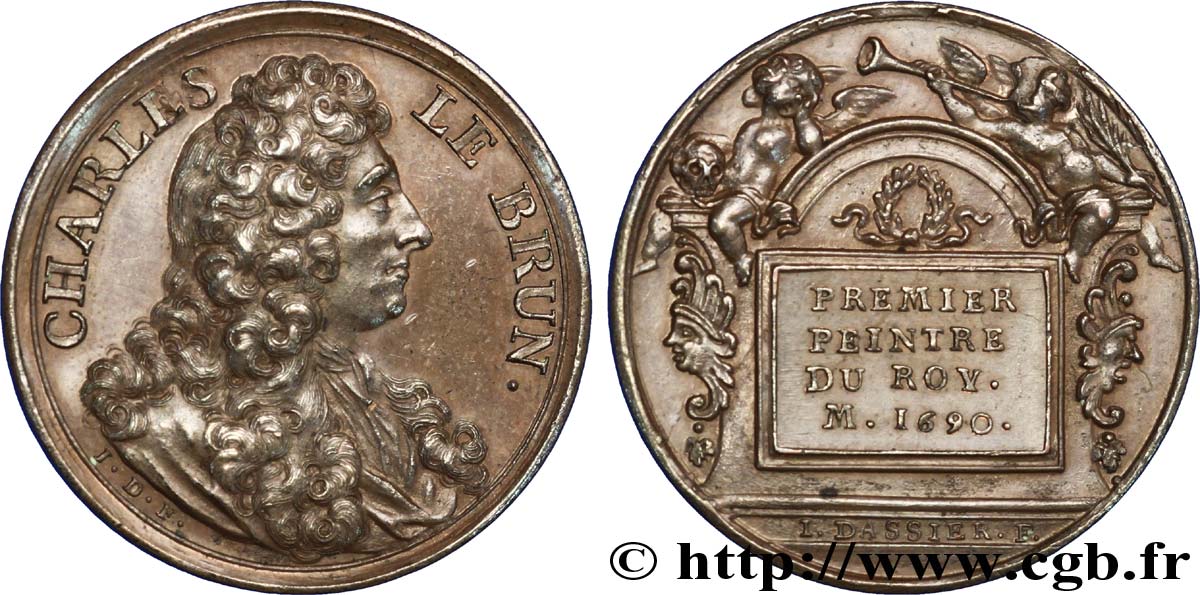
 Berichten über einen Fehler
Berichten über einen Fehler Die Seite drucken
Die Seite drucken Teilen meiner Auswahl
Teilen meiner Auswahl Stellen Sie eine Frage
Stellen Sie eine Frage Einlieferung/Verkauf
Einlieferung/Verkauf
 Details
Details


